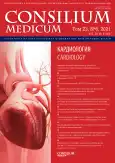Современная стратегия в лечении артериальной гипертонии: комбинированная терапия и фиксированные комбинации
- Авторы: Леонова М.В.1
-
Учреждения:
- Межрегиональная общественная организация «Ассоциация клинических фармакологов»
- Выпуск: Том 23, № 6 (2021)
- Страницы: 485-490
- Раздел: Статьи
- URL: https://journals.rcsi.science/2075-1753/article/view/95481
- DOI: https://doi.org/10.26442/20751753.2021.6.200942
- ID: 95481
Цитировать
Полный текст
Аннотация
Полный текст
Открыть статью на сайте журналаОб авторах
Марина Васильевна Леонова
Межрегиональная общественная организация «Ассоциация клинических фармакологов»
Email: anti23@mail.ru
д-р мед. наук, чл.-кор. РАЕН, проф. Россия
Список литературы
- Worldwide trends in blood pressure from 1975 to 2015: a pooled analysis of 1479 population-based measurement studies with 19.1 million participants. NCD Risk Factor Collaboration (NCD-RisC). Lancet. 2017;389(10064):37-55. doi: 10.1016/S0140-6736(16)31919-5
- Forouzanfar MH, Liu P, Roth GA, et al. Global burden of hypertension and systolic blood pressure of at least 110 to 115 mm Hg, 1990-2015. JAMA. 2017;317:165-82. doi: 10.1001/jama.2016.19043
- Global, regional, and national comparative risk assessment of 84 behavioural, environmental and occupational, and metabolic risks or clusters of risks for 195 countries and territories, 1990-2017: a systematic analysis for the Global Burden of Disease Study 2017. GBD 2017 Risk Factor Collaborators. Lancet. 2018;392(10159):1923-94. doi: 10.1016/S0140-6736(18)32225-6
- Mills KT, Bundy JD, Kelly TN, et al. Global disparities of hypertension prevalence and control: A systematic analysis of population-based studies from 90 countries. Circulation. 2016;134:441-50. doi: 10.1161/CIRCULATIONAHA.115.018912
- Кобалава Ж.Д., Конради А.О., Недогода С.В., и др. Артериальная гипертензия у взрослых. Клинические рекомендации 2020. Российский кардиологический журнал. 2020;25(3):149-218 [Kobalava ZhD, Konradi AO, Nedogoda SV, et al. Arterialnaia gipertenziia u vzroslykh. Klinicheskie rekomendatsii 2020. Rossiiskii kardiologicheskii zhurnal. 2020;25(3):149-218 (in Russian)]. doi: 10.15829/1560-4071-2020-3-3786
- Williams B, Mancia G, Spiering W, et al. 2018 ESC/ESH Guidelines for the management of arterial hypertension: The Task Force for the management of arterial hypertension of the European Society of Cardiology and the European Society of Hypertension: The Task Force for the management of arterial hypertension of the European Society of Cardiology and the European Society of Hypertension. J Hypertens. 2018;36(10):1953-2041. doi: 10.1097/HJH.0000000000001940
- Unger T, Borghi C, Charchar F, et al. 2020 International Society of Hypertension global hypertension practice guidelines. Hypertension. 2020;75(6):1334-57. doi: 10.1161/HYPERTENSIONAHA.120.15026
- Wright JT Jr, Williamson JD, et al. (SPRINT Research Group). A randomized trial of intensive versus standard blood-pressure control. N Engl J Med. 2015;373(22):2103-16. doi: 10.1056/NEJMoa1511939
- Ettehad D, Emdin CA, Kiran A, et al. Blood pressure lowering for prevention of cardiovascular disease and death: a systematic review and meta-analysis. Lancet. 2016;387:957-67. doi: 10.1016/S0140-6736(15)01225-8
- Staessen JA, Thijisq L, Fagard R, et al. Effects of immediate versus delayed antihypertensive therapy on outcome in the Systolic Hypertension in Europe Trial. J Hypertens. 2004;22(4):847-57. doi: 10.1097/00004872-200404000-00029
- Sica DA. The valsartan antihypertensive long-term use evaluation trial: a study in contrasts. Hypertension. 2006;48:362-3. doi: 10.1161/01.HYP.0000236117.13311.0f
- Tajeu GS, Kent ST, Huang L, et al. Antihypertensive medication nonpersistence and low adherence for adults №65 years initiating treatment in 2007-2014. Hypertension. 2019;74(1):35-46. doi: 10.1161/HYPERTENSIONAHA.118.12495
- Tajeu GS, Kent ST, Kronish IM, et al. Trends in antihypertensive medication discontinuation and low adherence among medicare beneficiaries initiating treatment from 2007 to 2012. Hypertension. 2016;68(3):565-75. doi: 10.1161/HYPERTENSIONAHA.116.07720
- Whelton PK, Carey RM, Aronow WS, et al. 2017 ACC/AHA/AAPA/ABC/ACPM/AGS/APhA/ASH/ASPC/NMA/ PCNA Guideline for the Prevention, Detection, Evaluation, and Management of High Blood Pressure in Adults: Executive Summary: A Report of the American College of Cardiology/American Heart Association Task Force on Clinical Practice Guidelines. Hypertension. 2018;71(6):1269-324. doi: 10.1161/HYP.0000000000000066
- World Health Organization Model List of Essential Medicines: 21st List 2019. Geneva: World Health Organization, 2019.
- Salam A, Kanukula R, Hariprasad E, et al. An application to include blood pressure lowering drug fixed dose combinations to the model list of essential medicines lists for the treatment of essential hypertension in adults. Geneva: World Health Organization, 2019.
- 2018 Chinese guidelines for prevention and treatment of hypertension - a report of the revision committee of Chinese guidelines for prevention and treatment of hypertension. Joint Committee for Guideline Revision. J Geriatr Cardiol. 2019;16(3):182-241. doi: 10.11909/j.issn.1671-5411.2019.03.014
- Guidelines on the management of arterial hypertension and related comorbidities in Latin America. Task Force of the Latin American Society of Hypertension. J Hypertens. 2017;35(8):1529-45. doi: 10.1097/HJH.0000000000001418
- Wald DS, Law M, Morris JK, et al. Combination therapy versus monotherapy in reducing blood pressure: meta-analysis on 11,000 participants from 42 trials. Am J Med. 2009;122(3):290-300. doi: 10.1016/j.amjmed.2008.09.038
- Shina SK. Monotherapy versus combination therapy for the initial treatment of hypertension. J Clin Prev Cardiol. 2020;9(2):78-83. doi: 10.4103/JCPC.JCPC_27_20
- DiPette DJ, Skeete J, Ridley E, et al. Fixed-dose combination pharmacologic therapy to improve hypertension control worldwide: clinical perspective and policy implications. J Clin Hypertens (Greenwich). 2019;21(1):4-15. doi: 10.1111/jch.13426
- Tsioufisa K, Kreutzb R, Sykarac G, et al. Impact of single-pill combination therapy on adherence, blood pressure control, and clinical outcomes: a rapid evidence assessment of recent literature. J Hypertens. 2020;38(6):1016-28. doi: 10.1097/HJH.0000000000002381
- Egan BM, Bandyopadhyay D, Shaftman SR, et al. Initial monotherapy and combination therapy and hypertension control the first year. Hypertension. 2012;59(6):1124-31. doi: 10.1161/HYPERTENSIONAHA.112.194167
- Mallat SG, Tanios BY, Itani HS, et al. Free versus fixed combination antihypertensive therapy for essential arterial hypertension: a systematic review and meta-analysis. PLoS One. 2016;11(8):e0161285. doi: 10.1371/journal.pone.0161285
- Parati G, Kjeldsen S, Coca A, et al. Adherence to single-pill versus free-equivalent combination therapy in hypertension: a systematic review and meta-analysis. Hypertension. 2021;77(2):692-705. doi: 10.1161/HYPERTENSIONAHA.120.15781
- Salam A, Kanukul R, Atkins E, et al. Efficacy and safety of dual combination therapy of blood pressurelowering drugs as initial treatment for hypertension: a systematic review and meta-analysis of randomized controlled trials. JHypertens. 2019;37(9):1768-74. doi: 10.1097/HJH.0000000000002096
- Tung YC, Huang YC, Wu LS, et al. Medication compliance and clinical outcomes of fixed-dose combinations vs free combinations of an angiotensin II receptor blocker and a calcium channel blocker in hypertension treatment. J Clin Hypertens (Greenwich). 2017;19(10):983-9. doi: 10.1111/jch.13035
- Ho CT, Tung YC, Chou SH et al. Clinical outcomes in hypertensive patients treated with a single-pill fixed-dose combination of renin-angiotensin system inhibitor and thiazide diuretic. J Clin Hypertens (Greenwich). 2018;20(12):1731-8. doi: 10.1111/jch.13413
Дополнительные файлы






